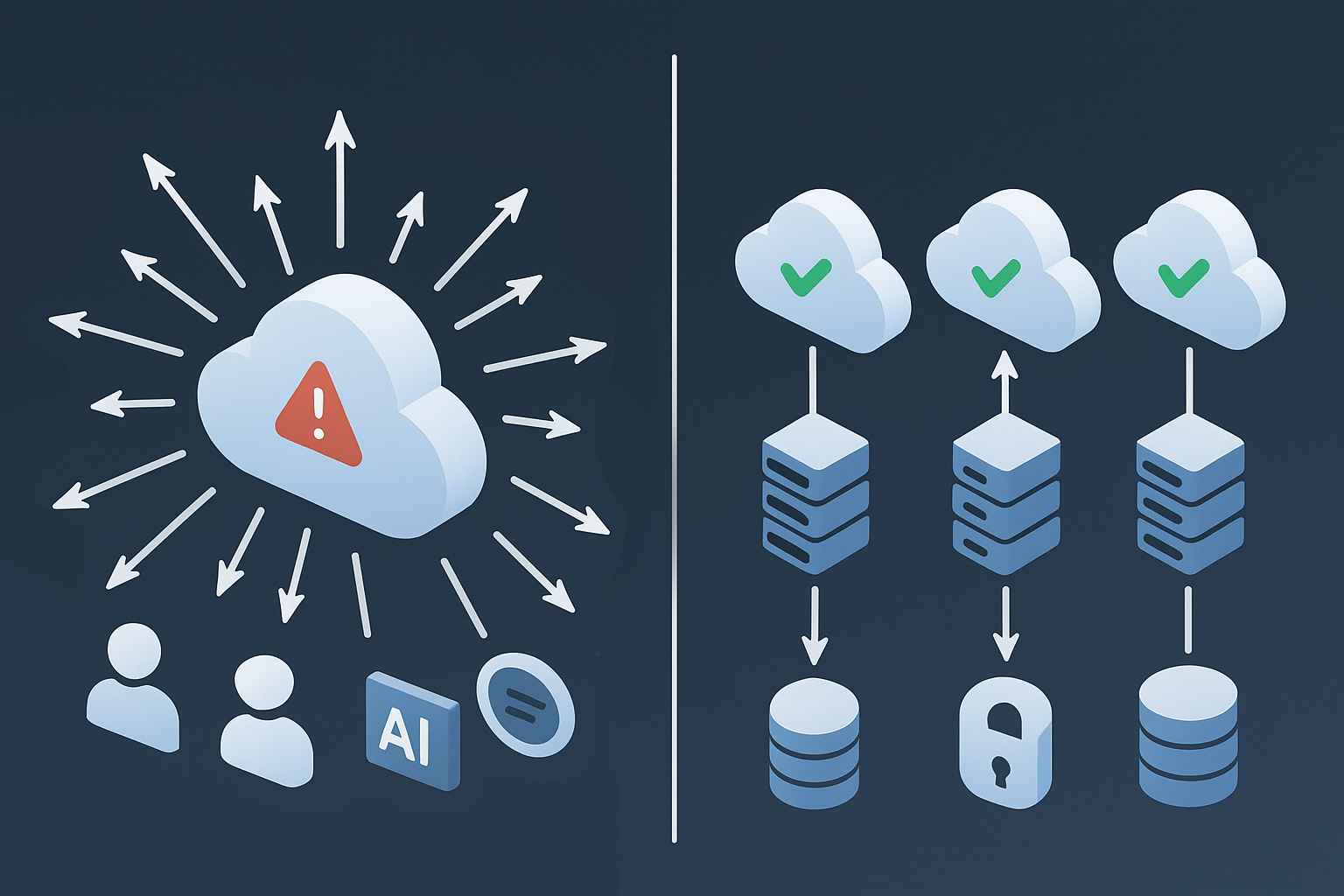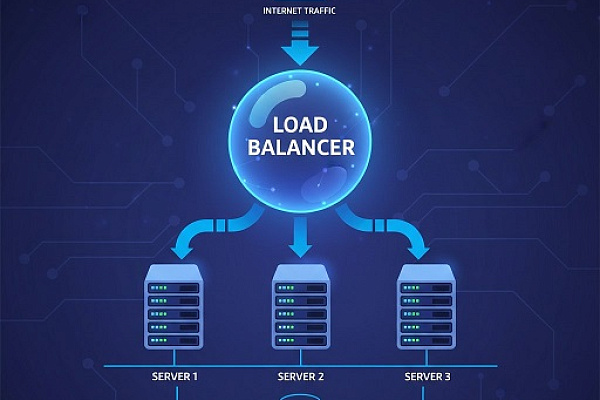For modern businesses, agility is paramount. This means controlling costs and rapidly deploying new technological solutions. In this context, using cloud technology is no longer an option but a necessity. However, relying on a single vendor can limit your options and hinder your infrastructure's growth.
The solution is a multi-cloud approach — a strategy where you use services from multiple cloud providers. This lets you avoid vendor lock-in and select the best environment for each specific task: cost-effective storage for data, powerful instances for predictive models, or archival solutions for backups without complex migrations or infrastructure overhauls.
What is a multi-cloud strategy?
A multi-cloud strategy involves using services from several cloud providers simultaneously. Instead of relying on a single provider for all needs, you distribute services across different platforms.
This is similar to managing a warehouse: you don't use the same storage for every item. Some need deep freezing, others require a vault, and some are fine on simple shelves. Similarly, with data: you can run mission-critical applications on high-performance hardware from one provider, while backups reside in low-cost storage from another. The key advantage is resilience: if one cloud experiences an outage, it won't trigger a company-wide IT collapse.
Key benefits of multi-cloud for business
1. Avoid vendor lock-in and maintain control
Becoming dependent on a single cloud provider can be restrictive. Switching vendors later often requires a lengthy and expensive redesign of your IT architecture.
Multi-cloud serves as a safeguard against this. Your company is no longer tied to a single vendor's ecosystem. You can freely adopt a new AI tool from a different provider or migrate workloads to a more cost-effective platform. This ensures your business remains agile.
2. Reduce cloud costs and optimize spending
Every cloud service has its own pricing model. For instance, archival data may be cheaper with one provider, while heavy computational tasks like neural network training are more cost-effective on another. Sometimes, it's more practical to use a pre-packaged, subscription-based AI service. A multi-cloud strategy lets you avoid paying for a one-size-fits-all solution and instead assemble an optimal toolkit for your specific needs.
3. Improve uptime and business continuity
No cloud service is immune to outages. Even industry giants experience downtime. For companies operating in a multi-cloud environment, these situations are less critical. Workloads can be redistributed, and users may not even notice an interruption.
4. Meet data sovereignty and compliance requirements
Modern regulations impose strict data sovereignty rules. Data from Russian users must reside within Russia, European data must stay within the EU, and other regions, like the UAE, may introduce new data mirroring requirements. Multi-cloud is a practical tactic, allowing you to store Russian user data in Moscow and German user data in Frankfurt, complying with both Russian Federal Law No. 152-FZ and GDPR simultaneously.
Enhancing data security with a multi-cloud approach
Relying on a single provider means that a configuration error or a vulnerability could potentially expose the entire ecosystem. With a multi-cloud setup, the data is distributed across different platforms, making it harder for attackers to breach all systems at once. If one provider is compromised, attackers won't gain access to your entire system. Furthermore, you can combine your own security policies with tools from different vendors, enhancing your overall security posture and reducing the risk of data leaks.
How to build a multi-cloud strategy
Step 1: analyze your IT needs and workloads
Before migrating, you must identify what to move, where, and why. Categorize your services:
- Mission-critical systems: Downtime directly results in financial loss (e.g., payments, order processing, core CRM)
- Performance-intensive services: Require high computing power (e.g., AI model training, real-time analytics)
- Background and non-production environments: Can operate on economical resources (e.g., archives, development/staging environments, backups)
Without this analysis, you risk building an expensive infrastructure that is either inefficient or unable to handle real-world loads. A clear strategy must come before signing any contracts.
Step 2: choose the right cloud providers
The quality of your multi-cloud setup depends on its components. The goal isn't to find one "perfect" supplier, but to assemble a combination of providers that best fit your specific tasks.
The market offers several strong providers, including Russian-based options like:
- Cloud4Y with its portfolio of business cloud solutions
- Rostelecom Cloud with its extensive regional infrastructure
- Selectel, which focuses on developers and flexible APIs
By using multiple platforms, a company gains both flexibility and risk mitigation.
Step 3: managing multi-cloud environments and integration
Different clouds mean different interfaces, rules, and security settings. A unified control and monitoring system is essential to prevent administrative chaos.
Step 4: implementing FinOps for cloud cost management
In an environment with dozens of services, it's easy to lose track of spending. Costs can escalate unexpectedly. This is where FinOps comes to the forefront. It involves continuous monitoring, identifying inefficiencies, and consciously reallocating resources. It's a disciplined approach to ensuring every dollar spent directly drives value.
Step 5: leveraging automation in multi-cloud
Managing a growing infrastructure manually is inefficient and risky. This increases the risk of missing a critical failure. Modern automation tools, from Terraform to Kubernetes, handle most of these tasks. They distribute load, respond to incidents, and maintain balance across different cloud environments without constant human intervention.
Is multi-cloud right for your business?
A multi-cloud approach delivers the most value when businesses face specific limitations and pain points: when traffic spikes exceed capacity, when legal teams struggle with regulations across multiple countries, or when scaling needs outpace a single provider's capabilities.
Global enterprises
For businesses with branches in dozens of countries, multi-cloud is essential. It allows you to deploy a server in Turkey for Middle Eastern and European clients while keeping Russian user data in Moscow, ensuring low latency for all users.
Fast-growing projects and startups
For startups that scale from 100 to 100,000 users overnight, multi-cloud provides a launchpad. It enables capacity scaling in hours, not weeks, by tapping into the most cost-effective resources available.
Data-sensitive industries
For banks, fintech, or healthcare companies, a data breach can be catastrophic. Multi-cloud serves as a risk diversification tool: even if attackers compromise one system, they cannot seize the entire digital arsenal.
Multi-cloud challenges
Multi-cloud is not a magic bullet. This strategy has its own complexities.
Management complexity
More providers mean a greater challenge for centralized control, requiring universal management tools and skilled specialists.
Increased security demands
More platforms mean more potential entry points to secure. Without a unified security policy, a multi-cloud environment can become a fragmented and vulnerable patchwork.
Additional costs
While multi-cloud can optimize spending, poor management can lead to unexpected expenses, such as fees for cross-cloud data transfer or system integration.
Talent gap
Administering a multi-cloud environment requires professionals skilled in multiple platforms, who can be difficult to find on the job market.
Conclusion
Adopting a multi-cloud strategy is a decisive step for businesses that depend on operational stability and data security. Implementation has its challenges, involving increased architectural complexity and potential for unmanaged costs. However, with a well-defined action plan and reliable partners, these challenges become manageable tasks. The reward is not just an abstract "advantage," but tangible operational freedom, greater reliability, and the agility to outpace competitors.




